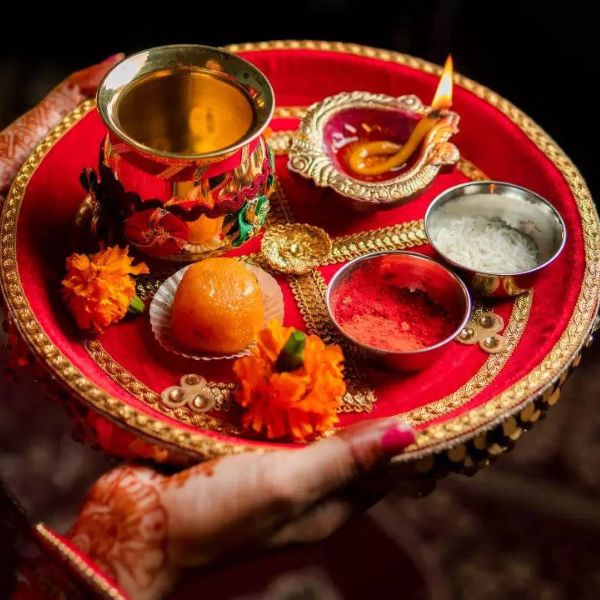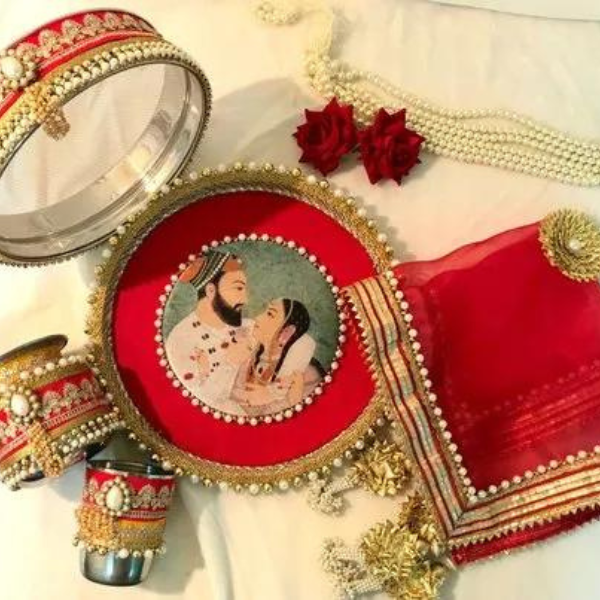Karwachauth, a significant festival celebrated predominantly by married Hindu women in North India, is a day dedicated to fasting for the well-being and longevity of their husbands. This auspicious occasion falls on the fourth day after the full moon in the month of Kartik, typically in October or November. The day is marked by a rigorous fast, beautiful rituals, and is steeped in cultural significance.

Significance of Karwachauth
The festival symbolizes the profound love and dedication that wives have for their husbands. It is a day when women pray for their husband’s health, prosperity, and longevity. The fast begins before sunrise and ends after sighting the moon. During this time, women adorn themselves in traditional attire, often wearing red or orange, and apply henna on their hands as a mark of celebration.
Rituals and Celebrations
- Sargi: The day starts with Sargi, a meal prepared by the mother-in-law, consumed before sunrise. This meal often includes fruits, sweets, and other delicacies, providing the necessary energy for the day-long fast.
- Fasting: Women observe a strict fast, refraining from food and water from sunrise until the moon is sighted. This fast is a test of endurance and commitment.
- Puja: In the evening, women gather to perform puja (prayers) to the moon and Goddess Parvati. They offer prayers, light diyas (lamps), and sing traditional songs.
- Breaking the Fast: Once the moon is sighted, women break their fast by sipping water first, followed by the first bite of food from their husband’s hands. This moment is symbolic of the bond and love between the couple.
Karwachauth Katha

Karwachauth is a significant festival celebrated by married Hindu women, where they fast for the well-being and longevity of their husbands. One of the essential components of this celebration is the Karwachauth Katha, a story that illustrates the depth of devotion and the power of love. Here’s a detailed look into the famous tales associated with Karwachauth, particularly focusing on the story of Veeravati.
Karwa Chauth Ki Katha | The Story of Veeravati
Ek baar ek gaon mein Veeravati naam ki ek sundar aur shreshth guno wali pativrata stree thi. Veeravati apne saat bhaiyon ki eklauti bahan thi, aur sabhi usse bahut pyaar karte the. Veeravati ki shaadi ek samarth raja se hui thi.
Pehli baar, Veeravati ne apne maayke mein Karwa Chauth ka vrat rakha. Subah se usne vrat rakha aur bina kuch khaye-peeye apne pati ke sukh-samridhi aur lambi umar ki prarthana ki. Shaam hone lagi, aur Veeravati ko bhook aur pyaas se chakkar aane lage, lekin usne apne vrat ko poora karne ka sankalp kiya.
Uske bhaiyon se apni bahan ki yeh dasha dekhi nahi gayi. Isliye unhone ek yojna banayi. Veeravati ke ek bhai ne peepal ke ped par chadh kar mashal jala di, taaki us mashal ka prakaash dekh kar Veeravati ko lagge ki chaand nikal aaya hai. Baaki bhaiyon ne kaha, “Behan, chaand nikal aaya hai, ab tum apna vrat tod do.”
Veeravati apne bhaiyon ki baat maan gayi aur bina chaand dekhe vrat tod diya. Jaise hi usne vrat toda, uske pati ki tabiyat bigadne lagi aur raja ki mrityu ho gayi. Veeravati apne pati ki yeh dasha dekh kar bahut dukhit hui aur rohne lagi.
Uska dard dekh kar ek devi uske saamne prakat hui aur usse kaha, “Tumne apne vrat ka palan poori shraddha ke saath nahi kiya, isliye tumhare pati ki aisi dasha hui hai. Ab tum nishtha ke saath vrat karo aur Karwa Chauth ka poora palan karo.”
Veeravati ne man mein sankalp kiya aur agle saal puri shraddha aur vishwas ke saath Karwa Chauth ka vrat kiya. Uske vrat se devi prasann hui aur uske pati ko jeevan daan diya. Veeravati aur uska pati phir se khushhal jeevan bitane lage.
Tab se har saal stree apne pati ki lambi umar ke liye Karwa Chauth ka vrat karti hain aur chaand ko arghya dekar apne vrat ko poora karti hain.
Significance of the Katha
The Karwachauth Katha is more than just a story; it embodies the essence of love, devotion, and the strength of a woman’s prayers. It teaches the following lessons:
- Devotion: The story emphasizes the importance of devotion in relationships. Veeravati’s unwavering love for her husband showcases how faith can overcome challenges.
- Patience: The narrative reflects the value of patience and persistence in one’s commitments. The festival teaches that true love often requires sacrifice and endurance.
- Cultural Heritage: Sharing the Katha during the Karwachauth rituals reinforces cultural values and traditions among women, fostering a sense of community and bonding.
- Spiritual Connection: The Katha also illustrates the spiritual connection between the devotee and the divine, highlighting that sincere prayers can lead to miracles.
The Ritual of Karwa Chauth Katha Narration
During the Karwachauth celebrations, women gather to recite the Katha as part of the puja (prayer) rituals. This communal aspect adds to the festival’s charm, as women share their experiences and strengthen their bonds. The narration of the Katha is often accompanied by traditional songs and dances, creating a vibrant atmosphere of joy and festivity.

